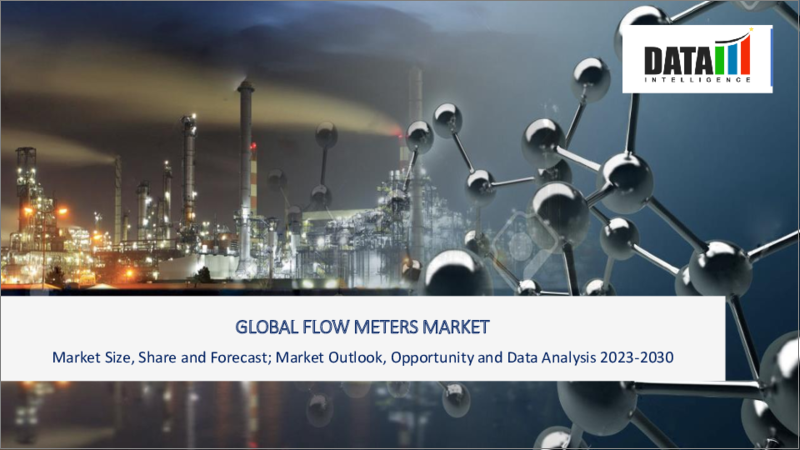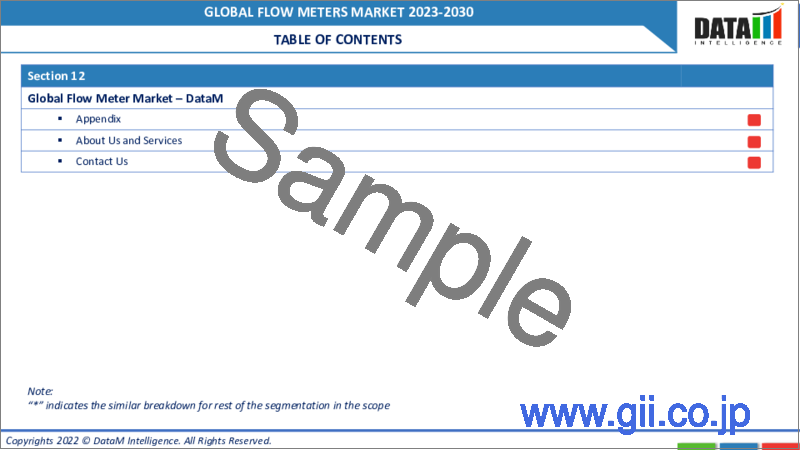|
|
市場調査レポート
商品コード
1304534
流量計の世界市場-2023年~2030年Global Flow Meters Market - 2023-2030 |
||||||
カスタマイズ可能
適宜更新あり
|
|||||||
| 流量計の世界市場-2023年~2030年 |
|
出版日: 2023年07月07日
発行: DataM Intelligence
ページ情報: 英文 195 Pages
納期: 即日から翌営業日
|
- 全表示
- 概要
- 目次
市場概要
流量計の世界市場は2022年に80億米ドルに達し、2023-2030年の予測期間中にCAGR 6.0%で成長し、2030年には127億米ドルに達すると予測されます。
世界の流量計市場は、アジア太平洋の新興国がより多くの需要を生み出すという需要パターンの変化を目の当たりにすると予想されます。この地域では、石油化学、発電、水管理、飲食品、医薬品など、ほとんどの主要エンドユーザー産業が力強い成長を遂げています。
さまざまな企業による新製品の発売も、市場の成長を押し上げる可能性が高いです。例えば、2023年3月、中国の流量計メーカーであるATO Flow Meter社は、石油・ガス、石油化学、医薬品など様々な産業で使用される新しい磁気式および超音波式流量計を発売しました。
市場力学
世界のエネルギー需要の増加
現代のライフスタイルはエネルギー密度が非常に高くなっています。世界のエネルギー需要は、特に新興諸国における経済発展の高まりとともに著しく増加しています。世界のエネルギー需要は、2021年には14,000Mtoe(石油換算で数百万トン)を超えると推定されています。世界のエネルギー需要は、2050年までに47%増加すると予想されています。エネルギー企業は、需要の増加を見込んで、陸上および海上の油田での生産を増やしています。
石油・ガス産業は、流量計の重要な需要源です。流量計は、原油・天然ガス・各種石油製品の流量を測定するために、上流・中流・下流の各工程で使用されます。世界の石油・ガス探査、生産、輸送活動の成長が、この業界の流量計需要を牽引しています。
廃水管理への注目の高まり
水の浪費は、近年重大な関心を集めています。米国地質調査所(USGS)は、年間1兆7,000億ガロン以上の水が浪費されていると推定しています。節水への幅広い動向の一環として、廃水リサイクルの重要性が高まっています。水不足と環境の持続可能性に対する懸念の高まりは、効果的な水・廃水管理の重要性を高めています。
流量計は、自治体の浄水場、工業施設、農業経営における水流の監視と制御に不可欠です。正確な測定、漏水検知、効率的な水使用の必要性が、上下水道管理分野における流量計の採用を促進しています。
複雑な設置とメンテナンス
流量計の適切な設置と構成には、しばしば専門的な知識と技術的な専門知識が必要とされます。流体力学、計装および制御システムの専門知識を持つ専門家は、正確な設置と最適な性能を保証しなければなりません。流量計を既存のシステムに組み込むことは複雑な場合があります。流量計は配管システム、制御システム、データ収集システムと組み合わせる必要があります。
流量計は、正確で信頼性の高い測定を保証するために、定期的な校正とメンテナンスを必要とします。校正は、メーターの出力を既知の標準と比較し、必要に応じて調整することを含みます。流量計は、設置やメンテナンスの際に一時的に取り外す必要があり、運転ワークフローを混乱させることがあります。それはダウンタイムを引き起こし、生産またはアクティブなプロセスに影響を与える可能性があります。
流量計の効果的な設置とメンテナンスには、訓練を受けた人材が必要です。企業は、従業員がこれらの作業を処理するために必要な知識とスキルを確実に身につけるために、従業員のトレーニングに投資する必要があります。専門的な訓練と技能開発の必要性は、流量計の導入に関連するコストと時間を増加させ、その結果、その需要を減少させる可能性があります。
COVID-19影響分析
COVID-19パンデミックはサプライチェーンを混乱させ、経済の不確実性を引き起こし、広範な操業停止を招き、産業活動の一時的な低下をもたらしました。その結果、石油・ガス、上下水道、化学、医薬品を含むいくつかのエンドユーザー業界では、流量計の需要が減少しました。
国際貿易の制限と製造施設の閉鎖は、流量計の生産と流通に影響を与えました。さらに、石油・ガス探査やインフラ開発のような産業におけるプロジェクトの遅延や中止は、流量計の需要をさらに減退させました。しかし、様々なセクターによる力強い復活により、流量計のニーズは順調に回復しており、世界の流量計市場は今後数年間で持続的な成長を遂げると予想されます。
AIの影響
AIアルゴリズムは、流量計によって収集された大量の流量データを分析し、パターンを特定し、貴重な洞察を提供することができます。これにより、企業は業務を最適化し、異常や潜在的な問題をリアルタイムで検出し、データ主導の意思決定を行うことができます。AIを活用することで、企業は流量測定の精度を高め、ダウンタイムを削減し、強化することができます。
流量計市場では、AIを活用した予知保全が脚光を浴びています。過去のデータを分析し、機械学習アルゴリズムを使用することで、流量計の潜在的な故障や不具合を事前に予測することができます。AI技術によりプロアクティブ・メンテナンスが可能になり、予期せぬダウンタイムを防ぎ、生産性の向上とコスト削減を実現します。システム全体のパフォーマンス
ウクライナ・ロシア紛争の影響
ロシア・ウクライナ紛争は、欧州における流量計の需要に大きな影響を与えました。欧州連合(EU)と米国による制裁により、ロシアは欧米の技術から遮断されました。この制裁により、ロシアの様々な産業からの流量計の需要が減少すると予想されます。しかし、その供給ギャップは、主に中国やインドのメーカーといった代替供給源によって埋められる可能性が高いです。
欧州も短期的には流量計の大幅な需要増を記録すると思われます。ロシアは重要な供給国であったため、紛争はエネルギー供給に混乱をもたらしました。しかし、この地域の国々は、米国や中東から液化天然ガス(LNG)を調達・貯蔵するための新たなインフラを整えつつあります。
目次
第1章 調査手法と調査範囲
第2章 定義と概要
第3章 エグゼクティブサマリー
第4章 市場力学
- 影響要因
- 促進要因
- プロセスの効率化とコスト削減の必要性
- 産業オートメーションの増加
- 世界のエネルギー需要の増加
- 廃水管理への注目の高まり
- 抑制要因
- 複雑な設置とメンテナンス
- 標準化の欠如
- 機会
- 影響分析
- 促進要因
第5章 産業分析
- ポーターのファイブフォース分析
- サプライチェーン分析
- 価格分析
- 規制分析
第6章 COVID-19分析
第7章 タイプ別
- 差圧式流量計
- 容積流量計
- 超音波流量計
- タービン流量計
- 磁気式流量計
- コリオリ流量計
- 渦流量計
- その他流量計
第8章 用途別
- 上下水道
- 石油・ガス
- 化学・石油化学
- 発電
- パルプ・製紙
- 飲食品
- その他
第9章 地域別
- 北米
- 米国
- カナダ
- メキシコ
- 欧州
- ドイツ
- 英国
- フランス
- イタリア
- スペイン
- その他欧州
- 南米
- ブラジル
- アルゼンチン
- その他南米
- アジア太平洋
- 中国
- インド
- 日本
- オーストラリア
- その他アジア太平洋地域
- 中東・アフリカ
第10章 競合情勢
- 競合シナリオ
- 市況/シェア分析
- M&A分析
第11章 企業プロファイル
- Honeywell International Inc.
- 会社概要
- 製品ポートフォリオと概要
- 財務概要
- 最近の動向
- Siemens
- Emerson Electric Co.
- ABB
- Yokogawa Electric Corporation
- Badger Meter, Inc
- Azbil Corporation
- Endress+Hauser Group Services AG
- KROHNE Messtechnik GmbH
- Bronkhorst
第12章 付録
Market Overview
The Global Flow Meters Market reached US$ 8.0 billion in 2022 and is expected to reach US$ 12.7 billion by 2030, growing with a CAGR of 6.0% during the forecast period 2023-2030.
The Global Flow Meters Market is expected to witness a shift in demand patterns, with more demand being generated by emerging countries of Asia-Pacific. Most major end-user industries, such as petrochemicals, power generation, water management, food & beverages and pharmaceuticals, are witnessing strong growth in the region.
New product launches by various players are also likely to augment market growth. For instance, in March 2023, ATO Flow Meter, a Chinese manufacturer of flow meters, launched new magnetic and ultrasonic flow meters for usage in various industries such as oil and gas, petrochemicals and pharmaceuticals.
Market Dynamics
Increasing Global Energy Demand
Modern lifestyles have become highly energy-dense. Global energy demand has increased significantly with rising economic development, especially in emerging countries. Global energy demand was estimated at more than 14,000 Mtoe (millions of tons of oil equivalent) in 2021. Global energy demand is expected to increase by 47% by 2050. Energy companies are increasing production at onshore and offshore oilfields in anticipation of rising demand.
The oil and gas industry is a significant source of demand for flow meters. Flow meters are used in upstream, midstream and downstream operations for measuring the flow rates of crude oil, natural gas and various petroleum products. The growth in oil and gas exploration, production and transportation activities worldwide drives this industry's demand for flow meters.
Increasing Focus on Wastewater Management
Water wastage has been attracting critical concern in recent years. The U.S. Geological Survey (USGS) estimates that more than 1.7 trillion gallons of water is wasted annually. Wastewater recycling has attracted more importance as a part of the broader trend toward water conservation. The growing concerns over water scarcity and environmental sustainability have heightened the importance of effective water and wastewater management.
Flow meters are critical in monitoring and controlling water flow in municipal water treatment plants, industrial facilities and agricultural operations. The need for accurate measurement, leak detection and efficient water usage is driving the adoption of flow meters in the water and wastewater management sector.
Complex Installation and Maintenance
Flow meters often require specialized knowledge and technical expertise for proper installation and configuration. Professionals with expertise in fluid dynamics, instrumentation and control systems must ensure accurate installation and optimal performance. Integrating flow meters into existing systems can be complex. Flow meters need to be combined with piping systems, control systems and data acquisition systems.
Flow meters require regular calibration and maintenance to ensure accurate and reliable measurements. Calibration involves comparing the meter's output against known standards and adjusting it if necessary. Flow meters may need to be temporarily removed from service during installation or maintenance activities, disrupting the operational workflow. It can cause downtime and impact production or active processes.
Effective installation and maintenance of flow meters require trained personnel. Companies need to invest in training their employees to ensure they have the necessary knowledge and skills to handle these tasks. The need for specialized training and skill development can increase costs and time associated with adopting flow meters, thus reducing their demand.
COVID-19 Impact Analysis
The COVID-19 pandemic disrupted supply chains, caused economic uncertainties and led to widespread lockdowns, resulting in a temporary decline in industrial activities. As a result, several end-user industries, including oil and gas, water and wastewater, chemicals and pharmaceuticals, experienced a decrease in demand for flow meters.
The restrictions on international trade and the closure of manufacturing facilities affected the production and distribution of flow meters. Moreover, project delays and cancellations in industries like oil and gas exploration and infrastructure development further dampened the demand for flow meters. However, with a strong resurgence by various sectors, the need for flow meters has recovered well and the Global Flow Meters Market is expected to post sustained growth in the coming years.
AI Impact
AI algorithms can analyze large volumes of flow data collected by flow meters, identify patterns and provide valuable insights. This enables companies to optimize their operations, detect anomalies or potential issues in real time and make data-driven decisions. By leveraging AI, companies can achieve higher accuracy in flow measurements, reduce downtime and enhance.
AI-powered predictive maintenance has gained prominence in the flow meters market. By analyzing historical data and using machine learning algorithms, potential faults or failures in flow meters can be predicted in advance. AI technology allows for proactive maintenance and prevents unexpected downtime, improving productivity and reducing costs. Overall system performance.
Ukraine-Russia War Impact
The Russia-Ukraine conflict has significantly impacted the demand for flow meters in Europe. Russia was cut off from Western technology due to the sanctions imposed by the European Union (EU) and the U.S. The sanctions are expected to reduce the demand for flow meters from various Russian industries. However, the supply gap will likely be filled by alternative sources, mainly Chinese and Indian manufacturers.
Europe will also record a significant increase in demand for flow meters in the short term. The conflict caused disruptions in energy supplies as Russia was a significant supplier. However, countries in the region are setting up new infrastructure for procuring and storing liquified natural gas (LNG) from the U.S. and the Middle East.
Segment Analysis
The Global Flight Simulator Market is segmented based on type, application and region.
Simplicity and Standardization Ensure Widespread Adoption of Differential Pressure Flow Meters
Differential pressure meters are relatively simple, consisting of a primary element, such as an orifice plate and a differential pressure transmitter. DP meters are often more cost-effective to install and maintain than other flow meter technologies, making them attractive for a wide range of applications. Meters can measure the flow rate of liquids, gases and steam and are suitable for various industries, including oil and gas, chemical, water and wastewater and manufacturing.
Differential pressure meters have been used for many years and have established industry standards and guidelines, such as those set by the American Petroleum Institute (API) and the International Organization for Standardization (ISO). The standardization ensures consistency and compatibility across different installations and simplifies the selection and calibration process.
Geographical Analysis
A Major Increase in Energy Exports Will Augment Market Growth in North America
North America is expected to occupy nearly a quarter of the global flow meters market. Due to the significant increase in natural gas production and the current prevailing geopolitical situation, the U.S. has emerged as a significant energy exporter. According to data from the U.S. government's energy information administration (EIA), the U.S. exported nearly 10.6 billion cubic feet of liquified natural gas (LNG) per day in 2022, exhibiting an increase of 9% over the previous year.
As the Ukraine-Russia war caused disruptions to European energy markets, LNG prices increased significantly, creating a significant export opportunity for the U.S. New LNG projects are being approved to increase production in response to the rising demand. For instance, in February 2023, it was reported that three new LNG projects, the Sempra Energy plant in Port Arthur, Texas, the Rio Grande plant in Texas and the Lake Charles plant in Louisiana, the U.S., could receive regulatory approvals later this year.
Competitive Landscape
The major global players include: Honeywell International Inc., Siemens, Emerson Electric Co., ABB, Yokogawa Electric Corporation, Badger Meter, Inc, Azbil Corporation, Endress+Hauser Group Services AG, KROHNE Messtechnik GmbH and Bronkhorst.
Why Purchase the Report?
- To visualize the Global Flight Simulator Market segmentation based on type, application and region and understand key commercial assets and players.
- Identify commercial opportunities by analyzing trends and co-development.
- Excel data sheet with numerous flight simulator market-level data points with all segments.
- PDF report consists of a comprehensive analysis after exhaustive qualitative interviews and an in-depth study.
- Product mapping available as Excel consisting of key products of all the major players.
The Global Flow Meter Market Report Would Provide Approximately 50 Tables, 56 Figures And 195 Pages.
Target Audience 2023
- Oil and Gas Companies
- Power Companies
- Industry Investors/Investment Bankers
- Research Professionals
- Emerging Companies
Table of Contents
1. Methodology and Scope
- 1.1. Research Methodology
- 1.2. Research Objective and Scope of the Report
2. Definition and Overview
3. Executive Summary
- 3.1. Snippet by Type
- 3.2. Snippet by Application
- 3.3. Snippet by Region
4. Dynamics
- 4.1. Impacting Factors
- 4.1.1. Drivers
- 4.1.1.1. Need for Process Efficiency and Cost Reduction
- 4.1.1.2. Increasing Industrial Automation
- 4.1.1.3. Increasing Global Energy Demand
- 4.1.1.4. Increasing Focus on Wastewater Management
- 4.1.2. Restraints
- 4.1.2.1. Complex Installation and Maintenance
- 4.1.2.2. Lack of Standardization
- 4.1.3. Opportunity
- 4.1.4. Impact Analysis
- 4.1.1. Drivers
5. Industry Analysis
- 5.1. Porter's Five Force Analysis
- 5.2. Supply Chain Analysis
- 5.3. Pricing Analysis
- 5.4. Regulatory Analysis
6. COVID-19 Analysis
- 6.1. Analysis of COVID-19
- 6.1.1. Scenario Before COVID
- 6.1.2. Scenario During COVID
- 6.1.3. Scenario Post COVID
- 6.2. Pricing Dynamics Amid COVID-19
- 6.3. Demand-Supply Spectrum
- 6.4. Government Initiatives Related to the Market During Pandemic
- 6.5. Manufacturers Strategic Initiatives
- 6.6. Conclusion
7. By Type
- 7.1. Introduction
- 7.1.1. Market Size Analysis and Y-o-Y Growth Analysis (%), By Type
- 7.1.2. Market Attractiveness Index, By Type
- 7.2. Differential Pressure Flow Meter*
- 7.2.1. Introduction
- 7.2.2. Market Size Analysis and Y-o-Y Growth Analysis (%)
- 7.3. Positive displacement Flow Meter
- 7.4. Ultrasonic Flow Meter
- 7.5. Turbine Flow Meter
- 7.6. Magnetic Flow Meter
- 7.7. Coriolis Flow Meter
- 7.8. Vortex Flow Meter
- 7.9. Others Flow Meter
8. By Application
- 8.1. Introduction
- 8.1.1. Market Size Analysis and Y-o-Y Growth Analysis (%), By Application
- 8.1.2. Market Attractiveness Index, By Application
- 8.2. Water & Wastewater*
- 8.2.1. Introduction
- 8.2.2. Market Size Analysis and Y-o-Y Growth Analysis (%)
- 8.3. Oil & Gas
- 8.4. Chemicals & Petrochemicals
- 8.5. Power Generation
- 8.6. Pulp & Paper
- 8.7. Food & Beverages
- 8.8. Others
9. By Region
- 9.1. Introduction
- 9.1.1. Market Size Analysis and Y-o-Y Growth Analysis (%), By Region
- 9.1.2. Market Attractiveness Index, By Region
- 9.2. North America
- 9.2.1. Introduction
- 9.2.2. Key Region-Specific Dynamics
- 9.2.3. Market Size Analysis and Y-o-Y Growth Analysis (%), By Type
- 9.2.4. Market Size Analysis and Y-o-Y Growth Analysis (%), By Application
- 9.2.5. Market Size Analysis and Y-o-Y Growth Analysis (%), By Country
- 9.2.5.1. The U.S.
- 9.2.5.2. Canada
- 9.2.5.3. Mexico
- 9.3. Europe
- 9.3.1. Introduction
- 9.3.2. Key Region-Specific Dynamics
- 9.3.3. Market Size Analysis and Y-o-Y Growth Analysis (%), By Type
- 9.3.4. Market Size Analysis and Y-o-Y Growth Analysis (%), By Application
- 9.3.5. Market Size Analysis and Y-o-Y Growth Analysis (%), By Country
- 9.3.5.1. Germany
- 9.3.5.2. The UK
- 9.3.5.3. France
- 9.3.5.4. Italy
- 9.3.5.5. Spain
- 9.3.5.6. Rest of Europe
- 9.4. South America
- 9.4.1. Introduction
- 9.4.2. Key Region-Specific Dynamics
- 9.4.3. Market Size Analysis and Y-o-Y Growth Analysis (%), By Type
- 9.4.4. Market Size Analysis and Y-o-Y Growth Analysis (%), By Application
- 9.4.5. Market Size Analysis and Y-o-Y Growth Analysis (%), By Country
- 9.4.5.1. Brazil
- 9.4.5.2. Argentina
- 9.4.5.3. Rest of South America
- 9.5. Asia-Pacific
- 9.5.1. Introduction
- 9.5.2. Key Region-Specific Dynamics
- 9.5.3. Market Size Analysis and Y-o-Y Growth Analysis (%), By Type
- 9.5.4. Market Size Analysis and Y-o-Y Growth Analysis (%), By Application
- 9.5.5. Market Size Analysis and Y-o-Y Growth Analysis (%), By Country
- 9.5.5.1. China
- 9.5.5.2. India
- 9.5.5.3. Japan
- 9.5.5.4. Australia
- 9.5.5.5. Rest of Asia-Pacific
- 9.6. Middle East and Africa
- 9.6.1. Introduction
- 9.6.2. Key Region-Specific Dynamics
- 9.6.3. Market Size Analysis and Y-o-Y Growth Analysis (%), By Type
- 9.6.4. Market Size Analysis and Y-o-Y Growth Analysis (%), By Application
10. Competitive Landscape
- 10.1. Competitive Scenario
- 10.2. Market Positioning/Share Analysis
- 10.3. Mergers and Acquisitions Analysis
11. Company Profiles
- 11.1. Honeywell International Inc.*
- 11.1.1. Company Overview
- 11.1.2. Type Portfolio and Description
- 11.1.3. Financial Overview
- 11.1.4. Recent Developments
- 11.2. Siemens
- 11.3. Emerson Electric Co.
- 11.4. ABB
- 11.5. Yokogawa Electric Corporation
- 11.6. Badger Meter, Inc
- 11.7. Azbil Corporation
- 11.8. Endress+Hauser Group Services AG
- 11.9. KROHNE Messtechnik GmbH
- 11.10. Bronkhorst
LIST NOT EXHAUSTIVE
12. Appendix
- 12.1. About Us and Services
- 12.2. Contact Us






